
|
NIMS Observes Melkart Crater on Ganymede
- Click the image above for a larger view
- Full-Res JPEG (445 x 525) (17.4 kB)
- Full-Res TIFF (445 x 525) (21.7 kB)
Caption:
The top figure is an image of the crater Melkart on Ganymede, at a wavelength of 0.85 microns, taken by the Near Infrared Mapping Spectrometer (NIMS) on the Galileo spacecraft, The crater is illuminated by the Sun from the left. The finest detail that can be seen is approximately 30 km in size. What is most obvious, and of great interest, are the two concentric ring structures and the central dome. The walls of these rings are in shadow on the left, and are in sunlight on the right. To understand how these rings and central dome are thought to form, consider a pebble dropped into a pond. Ripples spread out from the center, oscillating up and down. The rings and dome forming Melkart are a snapshot of these ripples in the ice of Ganymede, possibly caused by the impact of a comet or asteroid. Similar features on the Moon are only associated with much larger craters as the stronger Moon rock behaves this way only with large impacts. NIMS can obtain images at many different wavelengths from 0.7 to 5.2 microns.
The spectrum shows the amount of reflected light as a function of wavelength from the crater floor of Melkart. Several distinct absorption features, caused by water ice, are evident at 1.5 and 2.0 microns. Beyond 3.0 microns the intensity increases again as the longer wavelengths are more sensitive to Ganymede's thermal radiation. The shape of the absorption features suggest that the ice is mixed with hydrated minerals. These relatively dark minerals probably cause the variations in ice brightness seen at visible wavelengths.
Background Info:
The Jet Propulsion Laboratory, Pasadena, CA manages the mission for NASA's Office of Space Science, Washington, DC.
This image and other images and data received from Galileo are posted on the World Wide Web, on the Galileo mission home page at URL http://www.jpl.nasa.gov/ galileo.
Cataloging Keywords:
| Name | Value | Additional Values |
|---|---|---|
| Target | Ganymede | |
| System | Jupiter | |
| Target Type | Satellite | |
| Mission | Galileo | |
| Instrument Host | Galileo Orbiter | |
| Host Type | Orbiter | |
| Instrument | Near-Infrared Mapping Spectrometer (NIMS) | |
| Detector | ||
| Extra Keywords | Asteroid, Comet, Crater, Grayscale, Impact, Infrared, Moon, Shadow, Thermal, Water | |
| Acquisition Date | ||
| Release Date | 1998-03-26 | |
| Date in Caption | ||
| Image Credit | NASA/JPL | |
| Source | photojournal.jpl.nasa.gov/catalog/PIA00878 | |
| Identifier | PIA00878 | |
